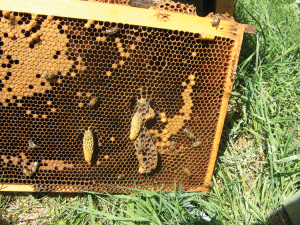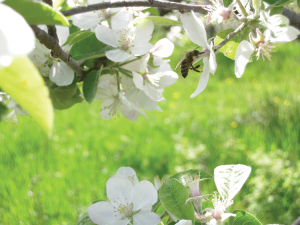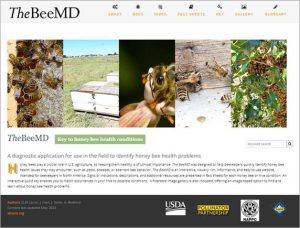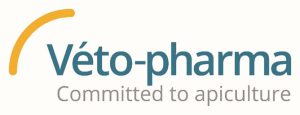By: Ross Conrad
The dose response characteristics of neonicotinoid insecticides turn out to be identical to those of genotoxic carcinogens, which are the most dangerous substances we know. Such poisons can have detrimental effects at any concentration level.
If you still think our primary problem is Varroa, poor nutrition, habitat destruction, etc., and don’t believe that pesticides is one of the primary issues, if not THE primary issue, for beekeepers today…think again.
In this third installment that came about as a result of my experience serving on the Vermont Pollinator Protection Committee, we explore the:
Impacts of neonicotinoid pesticides on honey bees (Apis mellifera)
As I stated in Part I of this series – all pesticides have the potential to have a harmful effect on honey bees. The reason so much focus and attention is paid to neonicotinoid insecticides is simply because they are among the most commonly used pesticides in the world.
The deadly impacts of neonicotinoids are obvious when bees are exposed to the contaminated dust from seed planting equipment (Greatti 2006; Krupke 2012; Tapparo 2012) or from the droplets of water (guttation fluid) exuded around the tips and leaf edges of plants (Girolami, 2009; Hoffman, 2012). While serious damage to beekeeping operations can occur from such exposure the primary risk to bees is not from such acute toxic reactions, but from chronic low-level exposure that may increase exponentially over time. Such exposure can make very small amounts of neonicotinoids much more toxic than previously realized.
Researchers have discovered why toxicity may occur after prolonged exposure to very low toxicant levels. Druckrey and Küpfmüller inferred in the late 1940s that if both receptor binding and the effect are irreversible, exposure time would reinforce the effect of the toxicant. In the 1960s they produced an equation that explains why toxicity may occur after prolonged exposure at very low levels. This dose –response characteristic has recently been established for insects like honey bees, with regard to the toxicity of imidacloprid and thiacloprid (Tennekes, 2011) and clothianidin. (Alkassab 2016)
Since imidacloprid and other neonicotinoid insecticides have time-dependent effects on arthropods such as bees, the risk of foraging worker bees consuming tiny residue levels becomes an issue that cannot be ignored. Researchers describe this paradigm shift in the field of toxicology this way: “The dose response characteristics of neonicotinoid insecticides turn out to be identical to those of genotoxic carcinogens, which are the most dangerous substances we know. Such poisons can have detrimental effects at any concentration level. (emphasis mine) Current pesticide risk assessment procedures are flawed and have failed to protect the environment. Traditional approaches that consider toxic effects at fixed exposure times are unable to allow extrapolation from measured endpoints to effects that may occur at other times of exposure. Time-to-effect approaches that provide information on the doses and exposure times needed to produce toxic effects on tested organisms are required for prediction of toxic effects for any combination of concentration and time in the environment.” (Tennekes, 2010)
In other words, the NEC (No Effect Concentration) for imidacloprid is estimated to be close to zero, which means that even extremely low residue concentrations of imidicloprid found in pollen or honey will have a lethal effect provided there is sufficient exposure time. This is a deadly situation for the honey bee workers that can lead to colony death during winter even when mites are under control, because the bees are restricted to consuming the neonic tainted honey and pollen stored in the hive.
Toxic effects from exposure to neonics include the finding that exposure to Thiamethoxam, damages the honey bee’s ability to fly and to navigate. In addition their ability to reproduce is impaired and their ability to forage effectively is reduced. Bees affected by neonicotinoids are also more vulnerable to disease and parasites. (Tirado 2013) These findings have been confirmed and supported by numerous studies.
The microsporidian Nosema is endemic in hives, but normally benign. However, when researchers feed bees a minute dose of imidacloprid, at a thousand times below the lethal dose that will kill 50 percent of the bees (LD50) and exposed them to Nosema, all the bees exposed to neonics die of Nosema, while none of the control hives also exposed, show any sign of disease. (Alaux 2010)
USDA research followed up on this study and clearly demonstrated that bees exposed to levels of imidicloprid that are undetectable using modern methods of detection, are significantly more vulnerable to nosema and this can lead to increased honey bee mortality and colony decline and collapse. Follow up testing of exposed bees for imidicloprid contamination showed no traces of the insecticide. The only way that researchers could confirm that the bees in their study were exposed to the insecticide is because they exposed the bees themselves. (Pettis 2012)
Another team of researchers discovered the mechanism which triggered the immune system deficiency Pettis described. Deformed Wing Virus (DWV) is present in all bee colonies, but is normally dormant and benign. However, when colonies were fed a tiny, field-relevant dose of neonicotinoids, thousands of bees would later be born with shriveled wings and the colony died. The scientists found that in test-colonies fed neonicotinoids the Deformed Wing Virus replicated 1,000 times faster than when colonies were neonic free. (Di Prisco 2013)
Such studies show that at field relevant doses imidicloprid has a crippling effect on the bees’ immune system allowing pathogens that may be present but not actively harming the colony to become deadly. This makes neonics the perfect killer. They destroy the immune system at levels that are undetectable, leaving other culprits to take the blame for colony deaths – whether it be Varroa mites, Deformed Wing Virus, Nosema, lack of forage and nutritional stress, poor beekeeping practices, abnormal weather –anything but neonicotinoid insecticides.
Meanwhile, a study published in the journal Chemosphere concluded that when bees are exposed to field realistic concentrations of the neonicotinoid thiamethoxam their lives are shortened. The “results suggest cellular organelle impairment that can compromise cellular function of the midgut cells, Malpighian tubules cells and Kenyon cells, and, consequently, can compromise the longevity of the bees of the whole colony.” (Friol, 2017)
Imidacloprid has also been shown to slow down the speed in which worker bees complete their foraging trips which creates the potential for insufficient food stores in hives. (Yang, 2008)
Additionally, recent research by Forfert and Moritz indicates that field realistic exposure to Thiacloprid significantly reduces the number of social interactions a worker will engage in with nest mates which could negatively impact recruitment of foragers. Interestingly, even though the exposed bees were less social, they transferred more food to the members that they contacted. This has the potential for serious repercussions in cases where hive diseases are being transmitted through the exchange of food. (Forfert and Moritz 2017)

Failed and supercedured queens seem to have become more common place ever since the use of neonicotinoid pesticides dramatically increased about 10 years ago.
In another recent paper that sheds light on neonics effect on honey bee social interactions, Papach, et. al., studied the impacts of honey bee exposure to thiamethoxam and American Foulbrood at the same time. There appeared to be no additive effect of the two stressors on larval mortality, however, they did find impaired cognitive performance (learning and memory) in honey bees fed the neonic during the larval stage. (Papach 2017)
When exposed to sunlight, neonicotinoids degrade and break down fairly rapidly. However, even neonicotinoid breakdown products are deadly to non-target organisms. One of imidacloprid’s breakdown products or metabolites, imidicloprid olefin, has been found to be at least as toxic as the parent product and also very persistent. (Suchail 2004)
Synergistic impacts of neonicotinoid pesticides.
Studies have also shown that bees exposed to a field-realistic dose of imidicloprid and Nosema at the same time experienced health impacts greater than either the pesticide or the disease alone. (Mondet 2009). Meanwhile, the U.S. EPA either ignores or downplays the synergistic impacts of neonicotinoids even though a ten-year old Paper Confirms USDA knew that imidacloprid had the potential for 1000-fold toxic synergistic effects when combined with fungicides. (CCD Steering Committee 2007) To quote directly from the CCD Steering Committee report: “Regarding pesticides, a new class of insecticides known as neonicotinoids is broadly and commonly used in most cropping systems and on turf and forest pests. One of the compounds in this class, imidacloprid, was banned in France, because it is acutely toxic to bees and since sub-lethal doses have been shown to impair honey bee short term memory; short-term memory is critical to bee navigational abilities necessary for foraging flights and for returning to the hive. USDA-funded research in North Carolina suggested that widely used fungicides synergize the effect of neonicotinoids 1,000-fold. (emphasis mine) Imidacloprid, applied as a systemic, has been found in corn, sunflower, and rape pollen at levels high enough to harm bees. [Although bees do not pollinate corn, they do collect corn pollen.]”
Queen issues
When it comes to queens, the news is no better. Work published in Scientific Reports found that “exposure to field-realistic concentrations of neonicotinoid pesticides can severely affect the immunocompetence of queens of western honeybees (Apis mellifera L.).” (Brandt 2017) Just like its effects on workers, neonics can make queens more vulnerable to diseases.
Our understanding of how neonicotinoids may impair short-term colony functioning due to the adverse effects of imidacloprid on queen bee fecundity and behavior increased greatly when researchers found neonicotinoids can reduce queen honey bee egg laying by as much as two-thirds, jeopardizing the health and stability of entire colonies. They also found colonies exposed to imidacloprid, collected and stored less pollen than insecticide-free colonies. Exposed colonies also removed just 74 percent of mite-infested or diseased pupae that infected the hive, compared to 95 percent removal by unexposed bees. (Wu-Smart and Spivak 2016)

Exposure to neonicotinoid pesticides while foraging can harm the foragers ability to survive, collect food, fight off diseases and support its colony . . . all of which may lead to increased colony decline and death.”
Then there is the finding that field realistic, sub-lethal doses of imidacloprid (0.02 ppm) and Coumaphos (100 ppm) decrease sperm viability in queens by 50%, one week after exposure. As has been confirmed by others, exposure also causes deformed wing virus (DWV) replication to increase in workers exposed to imidicloprid. (Chaimanee 2016)
The first study to identify problems with queens exposed to neonicotinoid pesticides was published in 2015 and found that exposure to field-realistic amounts of neonics compromises the reproductive system of the queen, reducing her chances of success. (Williams 2015) Subsequent research found that the synergistic combination of Imidacloprid and Nosema ceranae is more harmful to queens than either stressor separately. (Dussaubat 2016)
As the mother of the colony the queen can lay up to her bodyweight in eggs every day during the height of the season. It follows that she must eat close to her bodyweight in food every 24 hours. Research has shown that neonics affect the ability of honey bees to deposit acetylcholine in royal jelly and brood food. Since acetylcholine is critical to a healthy nervous system and functions as a neurotransmitter, a deficiency can have serious detrimental effects on survival of larvae. “Even field-relevant low concentrations of thiacloprid (200 ppb) or clothianidin (1 and 10 ppb) reduced the ACh level in the brood food and showed initial adverse effects on brood development.” (Wessler 2016). These findings are not surprising since nicotinoids themselves act on the central nervous system of insects, causing irreversible blockage of postsynaptic nicotinergic acetylcholine receptors (Ware 1999). Imidacloprid mimics the action of acetylcholine, but unlike acetylcholine, imidacloprid is not deactivated by the enzyme acetylcholinesterase and thus persistently activates the acetylcholine receptors. Chronic exposure to imidacloprid by insects therefore leads to cumulative and irreversible blockage of the acetylcholine receptors in their central nervous system. This has the potential to damage many development and cognitive processes. Unfortunately we don’t yet understand the full impacts on a colony when a queen is fed a diet that is deficient in acetylcholine.
Since the queen consumes much more food than worker bees, she has the potential to ingest a lot more pesticide residues than they do. We know that if a queen becomes sick or pheromone levels decline; if she isn’t laying the right amount of eggs; or if her behavior becomes abnormal in any way, the bees will tend to take pre-emptive action and attempt to supercede her with a new queen. The act of supercedure is costly for a colony as it slows down the population growth of the hive and there is always the risk that the newly raised queen will not successfully mate leaving the colony hopelessly queen-less.
For about a decade now, beekeepers have complained about queens that are not as vibrant and long-lived, are superseded more often, or just plain lousy. Are today’s queen problems the result of exposure to neonicotinoids? Given that neonics are proven to negatively harm honey bee health at high levels of exposure, as well as at levels below what our modern testing techniques can detect, the answer to the above question while difficult to answer definitively, appears all but certain given the evidence so far.
References
Alaux, C., Brunet, J.L., Dussaubat, C., Mondet, F., Tchamitchan, S., Cousin, M., Brillard, J., Baldy, A., Belzunces, L.P., Le Conte, Y, (2010) Interactions between Nosema microspores and a neonicotinoid weaken honeybees (Apis mellifera), Environmental Microbiology, 12(3): 774-782
Alkassab, A.T. and Kirchner, W.H., (2016) Impacts of chronic sublethal exposure to clothianidin on winter honeybees, Ecotoxicology 25(5):1000-1010
Brandt, A., Grikscheit, K., Siede, R., Grosse, R., Meixner, M.D., Buchler, R., (2017) Immunosupression in Honeybee Queens by the Neonicotinoids Thiacloprid and Clothianidin, Scientific Reports 7, Article Number 4673 doi:10.1038/s41598-017-04734-1
Girolami, V., L. Mazzon, A. Squatini, N. Mori, M. Marzaro, A. Dibernardo, M. Greatti, C. Giorio, and A. Tapparo (2009) Translocation of neonicotinoid insecticides from coated seeds to seedling guttation drops: a novel way of intoxication for bees. Journal of Economic Entomology 102(5):1808–1815.
CCD Steering Committee, Colony Collapse Disorder Action Plan. June 20, 2007. https://www.ars.usda.gov/ARSUserFiles/oc/br/ccd/ccd_actionplan.pdf
Chaimanee, V., Evans, J.D., Chen, Y., Jackson, C., Pettis, J.S., (2016) Sperm viability and gene expression in honey bee queens (Apis mellifera) following exposure to the neonicotinoid insecticide imidacloprid and the organophosphate arcaricide coumaphos, Journal of Insect Physiology 89:1-8 doi: 10.1016/j.jinsphys.2016.03.004
Di Prisco, G., Cavaliere, V., Annoscia, D., Varricchio, P., Caprio, E., Nazzi, F., Gargiulo, G., Pennacchio, F., (2013) Neonicotinoid Clothianidin adversely affects insect immunity and promotes replication of a viral pathogen in honey bees, Proceedings of the National Academy of Sciences 110:46 pp 18466-18471
Dussaubat, C., Maisonnasse, A., Crauser, D., Tchamitchian, S., Bonnet, M., Cousin, M., Kretzchmar, A., Brunet, J.L., Le Conte, Y., (2016) Combined neonicotinoid pesticide and parasite stress alter honeybee queens’ physiology and survival, Scientific Reports 6: Article number 31430 doi:10.1038/srep31430
Forfert, Nadège and Moritz, Robin (2017) Thiacloprid alters social interactions among honey bee workers (Apis mellifera). Journal of Apicultural Research, 56(4):467-474
Friol, P.S., Catae, A.F., Tavares, D.A., Malaspina, O., Roat, T.C., (2017) Can the exposure of Apis mellifera (Hyenoptera: Apidae) larvae to a field concentration of thiamethoxam affect newly emerged bees? Chemosphere, 29;185:56-66
Greatti, M., R. Barbattini, A. Stravisi, A. G. Sabatini, and S. Rossi. (2006) Presence of the a.i. imidacloprid on vegetation near corn fields sown with Gaucho® dressed seeds. Bulletin of Insectology 59(2):99–103.
Hoffmann, E. J., and S. J. Castle, (2012) Imidacloprid in melon guttation fluid: A potential mode of exposure for pest and beneficial organisms. Journal of Economic Entomology 105(1):67–71.
Krupke, C. H., G. J. Hunt, B. D. Eitzer, G. Andino, and K. Given. (2012) Multiple routes of pesticide exposure for honey bees living near agricultural fields. PLoS ONE 7(1):e29268.
Mondet, F., (2009). Nosema and imidacloprid synergy affects immune-strength-related enzyme activity in the honey bee, Apis mellifera (Rapport de stage, Université Claude Bernard (Lyon 1), Villeurbanne, FRA). http://prodinra.inra.fr/record/36474
Papach, A., Fortini, D., Grateau, S., Aupinel, P., Richard, F.J., (2017) Larval exposure to thiamethoxam and American foulbrood: effects on mortality and cognition in the honey bee Apis mellifera. Journal of Apicultural Research, 56(4):475-486 DOI: 10.1080/00218839.2017.1332541
Pettis JS, VanEngelsdorp D, Johnson J, Dively G. (2012) Pesticide exposure in honey bees results in increased levels of the gut pathogen Nosema. Naturwissenschaften. 99:153–158. (doi: 10.1007/s00114-011-0881-1)
Suchail S, Debrauwer L, Belzunces LP (2004) Metabolism of imidacloprid in Apis mellifera. Pest Management Science 60: 291–296 [PubMed])
Tapparo, A., D. Marton, C. Giorio, A. Zanella, L. Soldà, M. Marzaro, L. Vivan, and V. Girolami. (2012) Assessment of the environmental exposure of honeybees to particulate matter containing neonicotinoid insecticides coming from corn coated seeds. Environmental Science & Technology 46(5):2592–2599.
Tennekes, H.A., Systemic Neonicotinoids: A Disaster in the Making? (ETS Nederland BV, 2010).
Tennekes, H.A., Sanchez-Bayo, F., (2011) Time-Dependent Toxicity of Neonicotinoids and Other Toxicants: Implications for a New Approach to Risk Assessment. Journal of Environmental & Analytical Toxicology. S4:001. doi: 10.4172/2161-0525.S4-001
Tirado, R., Simon, G., Johnston, P., (2013) Bees in Decline: A review of factors that put pollinators and agriculture in Europe at risk, Greenpeace Research Laboratories Technical Report, (Review)
Ware, G.W., (1999) An Introduction to Insecticides (3rd Edition), University of Minnesota. Accessed August 2017 – https://www.boerenlandvogels.nl/sites/default/files/2016-11/Ware2002IntroductionInsecticides.pdf
Wessler, I., Gartner, HA., Michel-Schmidt, R., Brochhausen, C., Schmitz, L., Anspach, L., Grunewald, B., Kirkpatrick, C.J., (2016) Honeybees produce millimolar concentrations of non-neuronal acetylcholine for breeding: Possible adverse effects of neonicotinoids, PLoS ONE, 11(6):e0156886. doi:10.1371/journal.pone.0156886
Williams, G.R., Troxler, A., Retschnig, G., Roth, K., Yanez, O., Shutler, D., Neumann, P., Gauthier, L., (2015) Neonicotinoid pesticides severely affect honey queen bees, Scientific Reports (5)14621: doi:10.1038/srep14621
Wu-Smart, J., Spivak, M., (2016) Sub-lethal effects of dietary neonicotinoid insecticide exposure on honey bee queen fecundity and colony development, Scientific Reports 6, Article Number 32108 doi:10.1038/srep32108
Yang, E.C., Chuang, Y.C., Chen, Y.L., Chang, L.H., (2008) Abnormal foraging behavior induced by sublethal dosage of imidacloprid in the honey bee (Hymenoptera: Apidae), Journal of Economic Entomology 101(6):1743-1748
Ross Conrad is the author of Natural Beekeeping: Revised and Expanded 2nd Edition.








